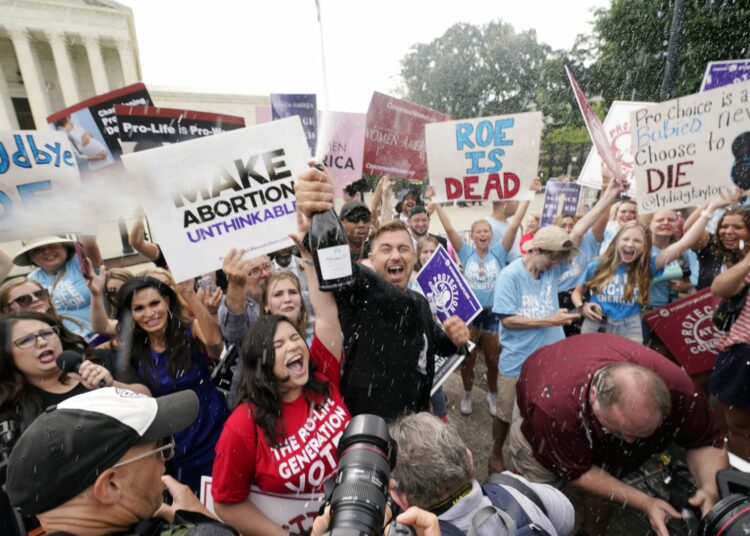Last updated on July 6th, 2022 at 09:16 am
It turns out I was right. In a series of articles for ifamnews.com, I detailed the legal issues presented in the state of Mississippi’s challenge to Roe v Wade, which created a constitutional “right” to abortion in 1973 and Planned Parenthood v Casey which refashioned abortion rules nearly twenty years later, but reaffirmed the “right” created by Roe. I forecast that at least five justices – Alito, Gorsuch, Thomas, Kavanaugh and Barrett – would use the Dobbs v Jackson Women’s Health Organization case to overturn Roe and Casey. I noted that there would be tremendous pressure, including protests and threats of violence, brought to bear by abortion sympathizers in an attempt to intimidate the justices into preserving Roe. I contested the view of some highly-respected legal analysts that Chief Justice John Roberts would join with the principled conservatives to overturn Roe, predicting that he would ultimately lack the courage to do so.
In the end, pretty much all of these observations proved to be correct. The Court ruled 5-4 to overturn Roe and Casey. (Many in the media report the Dobbs decision as being 6-3 with Roberts in the majority, but that is incorrect. Roberts authored a concurring opinion making clear that he would have upheld Mississippi’s law prohibiting abortions at 15 weeks, but did not agree that Roe and Casey should be reversed.)
While I said in my articles that the Dobbs decision had the potential to roil the country like no other court decision in most people’s lifetimes, there were several developments I did not predict. I did not think it possible that someone within the Supreme Court itself–likely a law clerk for a liberal justice–would leak the draft opinion to the media for the purpose of stoking outrage on the left in order to ramp up pressure on one of the conservatives to change his or her vote. And while I said that the justices would be subjected to the most intense pressure campaign ever mounted, including demonstrations at their homes, I did not predict that the effort to change the projected vote would include an assassination attempt on one of the justices.
Despite all the hue and cry and the countless words spilled by both sides of the abortion issue in the wake of the Dobbs decision, the rationale of the Supreme Court majority in overturning Roe is actually quite simple and straightforward. Reflecting an originalist view of the law, the majority correctly believes that there are only two circumstances where courts can find a constitutional right: it must either be expressly enumerated in the text of the Constitution itself, or be readily inferred based on the nation’s history and traditions existing at the time the Constitution was ratified. Neither Roe nor Casey met those conditions, and thus they were wrongly decided from the outset. There is not, and never has been, a constitutional right to abortion in America.
With the Dobbs decision, the regulation of abortion will be returned to the states to be decided consistent with the 10th Amendment to the Constitution (“The powers not delegated to the United States by the Constitution, nor prohibited by it to the States, are reserved to the States respectively, or to the people.) and other constitutional provisions.
In the short term, the regulation of abortion will hue very closely to the general political lineup of states in our currently divided America. Deep blue states like New York and California will continue to allow for expansive abortion access and indeed will go further by positioning their states as “abortion sanctuaries.” Many deep red states, on the other hand, will prevent abortion entirely (except to preserve the life of the mother). Indeed, many have previously passed “trigger laws” that are now kicking in to ban or severely limit abortion. Still other states will look for some sort of balance, allowing abortions in some cases but prohibiting them in many other cases.
The short term will also see lots of chaos and confusion as the pro-life and pro-abortion camps continue to duel. Courts have temporarily blocked trigger laws from taking effect at the request of abortion providers, but it is highly unlikely that these temporary restraining orders will become permanent once the appellate courts get involved. President Joe Biden and leading Democrats have called on Congress to codify Roe (the legislation in question to do so would actually vastly expand Roe to include abortion on demand at any time of pregnancy), going so far as to eliminate the filibuster in order to pass the legislation. But that effort is likely to fizzle because two prominent Democrat Senators, Joe Manchin and Kyrsten Sinema, are opposed to breaking the filibuster rule. Biden will issue various executive orders to promote abortion access (constructing abortion facilities on federal lands has been suggested by some) but the Courts will almost certainly invalidate them for lacking legal authority. Packing the Supreme Court to give Biden the chance to nominate more liberal justices will be attempted, but will fail.
Abortion regulation will also become a hot political issue in the short term. Democrats are hoping to make it the preeminent issue of the 2022 midterm elections, believing that support for abortion will be enough to drive massive turnout benefiting Democrats. That is a fantasy. While passion is high on the abortion issue, it is high on both sides. Those who care most about preserving access to abortion mostly live in areas of the country – blue cities and states – that will continue to provide for easy access to abortion. Some people in swing areas, particularly suburban women, may prefer to allow continued access to abortion, but they have far more pressing concerns about the state of the economy, the increasingly untenable rising cost of living, and the Left’s insistence on imposing a woke progressive agenda on their children. Moreover, lots of these suburban moms live in purple states that are highly likely to continue some access to abortion.
What of the long term?
The long-term battle over abortion remains what it has always been–a battle for the hearts and minds of the American people. As others have noted, the focus of the pro-life community should not be so much on making abortion illegal as making it unthinkable. It will take much more time, but the trends in public sentiment are certainly encouraging.
There is another important long-term opportunity that stems from the Supreme Court’s abortion ruling. The legal reasoning underpinning the Dobbs decision–that constitutional rights exist only when specifically mentioned in the text of the Constitution or readily inferred from the nation’s history and traditions–has implications for numerous other “rights” invented by activist judges. Chief among them is same-sex ‘marriage.’ Like abortion, gay ‘marriage’ is not an enumerated right in the text of the Constitution, and did not have any history or tradition when the Constitution and the various amendments were ratified. Of all the “rights” that have been created by judges over the years, gay ‘marriage’ is the most vulnerable. Distinguished law professor Helen Alvare recently said the Obergefell v Hodges case that imposed gay ‘marriage’ on the nation, “is almost entirely built on Casey’s rationale that individual rights respecting sex and identity creation are fundamental constitutional rights. And Casey is gone.”
The more than 50 million Americans who voted in dozens of state referenda and amendment campaigns to define marriage solely as the union of one man and one woman, and countless legislators who did the same by enacting state statutes, can only hope that Obergefell will be soon gone as well.




















Discussion about this post